Management Accounting Report: Costing Methods and Budgeting Strategies
VerifiedAdded on 2019/12/18
|17
|5249
|210
Report
AI Summary
This report delves into the core concepts of management accounting, exploring its significance for businesses like Imda Tech (UK) Limited. It differentiates between management and financial accounting, highlighting the role of management accounting in decision-making, product costing, and budgeting. The report analyzes various management accounting systems, including cost accounting and inventory management. Furthermore, it examines costing methods, comparing marginal and absorption costing through income statements, and discusses different types of budgets along with their respective advantages and disadvantages. The report also touches upon pricing strategies and the balance scorecard approach, providing a comprehensive overview of management accounting practices and their practical application in a business context.

MANAGEMENT ACCOUNTING
Paraphrase This Document
Need a fresh take? Get an instant paraphrase of this document with our AI Paraphraser

TABLE OF CONTENTS
INTRODUCTION...........................................................................................................................4
TASK 1............................................................................................................................................4
a)..................................................................................................................................................4
i) Define management accounting and different between management and financial accounting
.....................................................................................................................................................4
ii Importance of management accounting information................................................................6
b) Different types of management accounting systems...............................................................7
TASK 2............................................................................................................................................8
Costing methods..........................................................................................................................8
TASK 3..........................................................................................................................................10
(a)Different type of budgets and their advantages as well as disadvantages.............................10
© Pricing strategies....................................................................................................................13
TASK 4..........................................................................................................................................13
a) Balance score card approach.................................................................................................13
CONCLUSION..............................................................................................................................15
REFERENCES..............................................................................................................................16
INTRODUCTION...........................................................................................................................4
TASK 1............................................................................................................................................4
a)..................................................................................................................................................4
i) Define management accounting and different between management and financial accounting
.....................................................................................................................................................4
ii Importance of management accounting information................................................................6
b) Different types of management accounting systems...............................................................7
TASK 2............................................................................................................................................8
Costing methods..........................................................................................................................8
TASK 3..........................................................................................................................................10
(a)Different type of budgets and their advantages as well as disadvantages.............................10
© Pricing strategies....................................................................................................................13
TASK 4..........................................................................................................................................13
a) Balance score card approach.................................................................................................13
CONCLUSION..............................................................................................................................15
REFERENCES..............................................................................................................................16

INTRODUCTION
It is essential for each and every business enterprise to record their transactions in day to
day operations. Thus, for such purpose business requires to undertake management accounting
concept and provide financial information to other stakeholders. Business appoint accountants to
record financial transactions so that information could be recorded in a timely manner. However,
it also proves to be very efficient tool and thus results in directing and controlling the actions of
business (Otley and Emmanuel, 2013). It has been assessed that there has been great difference
lies in management and financial accounting. They both are different from each other.
Management accounting is considered as the decision making tool that provides different
information regarding purchase or sell, product costing and budgeting etc. While, financial
accounting is prepared in relation manage orecord financial information so that shareholders
could be given best information regarding investment (Fullerton, Kennedy and Widener, 2013).
Present study has been prepared in relation to Imda Tech (UK) Limited in relation to manage
their accounting information which results in achieving desired goals and objectives. Report
analyses the income statement which is developed on the basis of Marginal and Absorption
costing techniques. Also, it discusses the advantages and disadvantages of different types of
budget.
TASK 1
a)
i) Define management accounting and different between management and financial accounting
The concept of management accounting is considered as the process through which
crucial information could be identified, analyzed, measured and interpret the financial data so
that desired results could be attained. Hence, manager of Imda Tech Limited needs to make their
day to day transactions of business which results firm to carry out their functions in an effective
way. Main purpose of preparing such accounting system is helping firm to look forward and
execute internal affairs so that success can be attained (Bhimani and et. al., 2013). Management
accounting is crucial part of business and thus helps them to improve their corporate brand
image. There also lies tough competition and thus Imda needs to prepare good budget so that
It is essential for each and every business enterprise to record their transactions in day to
day operations. Thus, for such purpose business requires to undertake management accounting
concept and provide financial information to other stakeholders. Business appoint accountants to
record financial transactions so that information could be recorded in a timely manner. However,
it also proves to be very efficient tool and thus results in directing and controlling the actions of
business (Otley and Emmanuel, 2013). It has been assessed that there has been great difference
lies in management and financial accounting. They both are different from each other.
Management accounting is considered as the decision making tool that provides different
information regarding purchase or sell, product costing and budgeting etc. While, financial
accounting is prepared in relation manage orecord financial information so that shareholders
could be given best information regarding investment (Fullerton, Kennedy and Widener, 2013).
Present study has been prepared in relation to Imda Tech (UK) Limited in relation to manage
their accounting information which results in achieving desired goals and objectives. Report
analyses the income statement which is developed on the basis of Marginal and Absorption
costing techniques. Also, it discusses the advantages and disadvantages of different types of
budget.
TASK 1
a)
i) Define management accounting and different between management and financial accounting
The concept of management accounting is considered as the process through which
crucial information could be identified, analyzed, measured and interpret the financial data so
that desired results could be attained. Hence, manager of Imda Tech Limited needs to make their
day to day transactions of business which results firm to carry out their functions in an effective
way. Main purpose of preparing such accounting system is helping firm to look forward and
execute internal affairs so that success can be attained (Bhimani and et. al., 2013). Management
accounting is crucial part of business and thus helps them to improve their corporate brand
image. There also lies tough competition and thus Imda needs to prepare good budget so that
⊘ This is a preview!⊘
Do you want full access?
Subscribe today to unlock all pages.

Trusted by 1+ million students worldwide
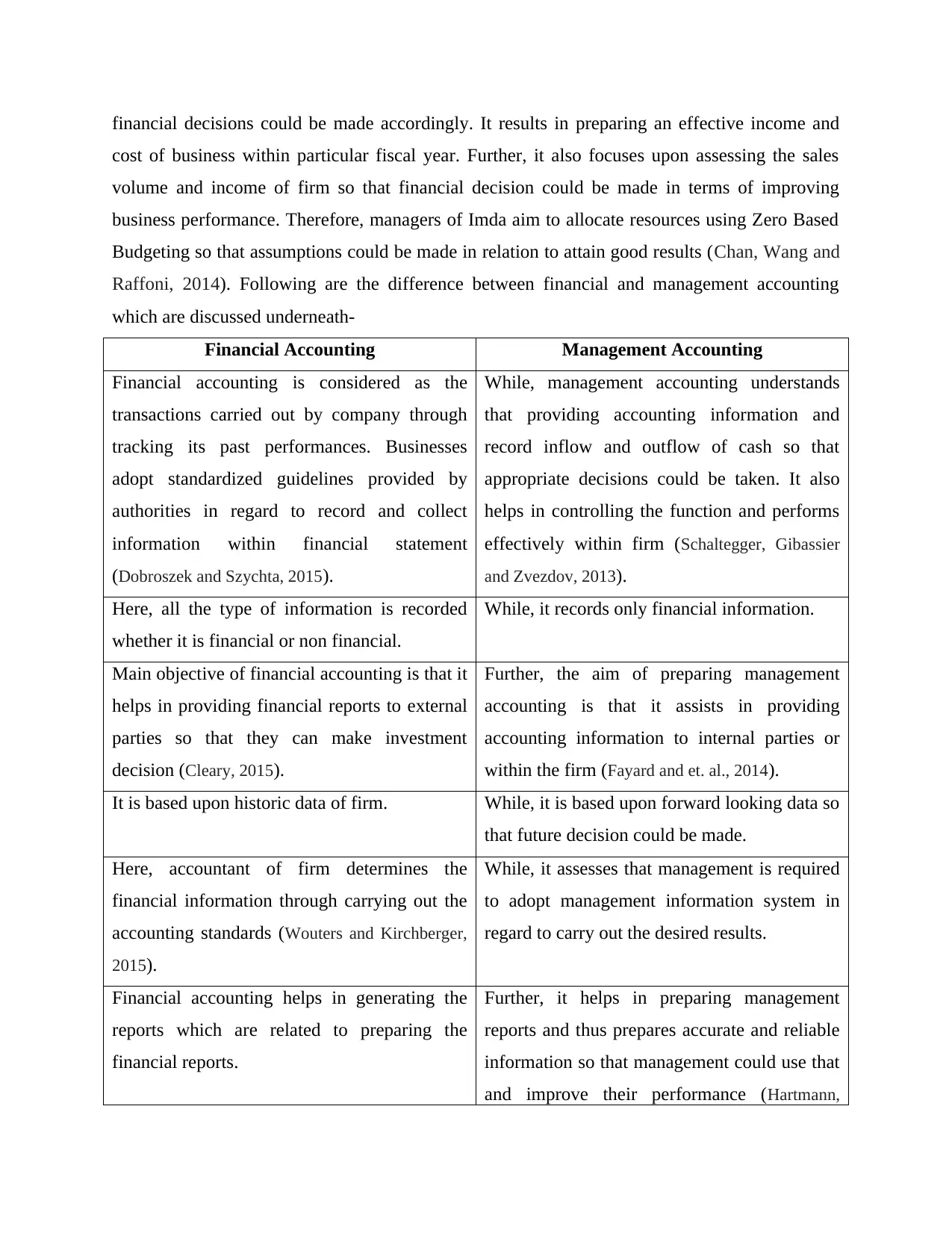
financial decisions could be made accordingly. It results in preparing an effective income and
cost of business within particular fiscal year. Further, it also focuses upon assessing the sales
volume and income of firm so that financial decision could be made in terms of improving
business performance. Therefore, managers of Imda aim to allocate resources using Zero Based
Budgeting so that assumptions could be made in relation to attain good results (Chan, Wang and
Raffoni, 2014). Following are the difference between financial and management accounting
which are discussed underneath-
Financial Accounting Management Accounting
Financial accounting is considered as the
transactions carried out by company through
tracking its past performances. Businesses
adopt standardized guidelines provided by
authorities in regard to record and collect
information within financial statement
(Dobroszek and Szychta, 2015).
While, management accounting understands
that providing accounting information and
record inflow and outflow of cash so that
appropriate decisions could be taken. It also
helps in controlling the function and performs
effectively within firm (Schaltegger, Gibassier
and Zvezdov, 2013).
Here, all the type of information is recorded
whether it is financial or non financial.
While, it records only financial information.
Main objective of financial accounting is that it
helps in providing financial reports to external
parties so that they can make investment
decision (Cleary, 2015).
Further, the aim of preparing management
accounting is that it assists in providing
accounting information to internal parties or
within the firm (Fayard and et. al., 2014).
It is based upon historic data of firm. While, it is based upon forward looking data so
that future decision could be made.
Here, accountant of firm determines the
financial information through carrying out the
accounting standards (Wouters and Kirchberger,
2015).
While, it assesses that management is required
to adopt management information system in
regard to carry out the desired results.
Financial accounting helps in generating the
reports which are related to preparing the
financial reports.
Further, it helps in preparing management
reports and thus prepares accurate and reliable
information so that management could use that
and improve their performance (Hartmann,
cost of business within particular fiscal year. Further, it also focuses upon assessing the sales
volume and income of firm so that financial decision could be made in terms of improving
business performance. Therefore, managers of Imda aim to allocate resources using Zero Based
Budgeting so that assumptions could be made in relation to attain good results (Chan, Wang and
Raffoni, 2014). Following are the difference between financial and management accounting
which are discussed underneath-
Financial Accounting Management Accounting
Financial accounting is considered as the
transactions carried out by company through
tracking its past performances. Businesses
adopt standardized guidelines provided by
authorities in regard to record and collect
information within financial statement
(Dobroszek and Szychta, 2015).
While, management accounting understands
that providing accounting information and
record inflow and outflow of cash so that
appropriate decisions could be taken. It also
helps in controlling the function and performs
effectively within firm (Schaltegger, Gibassier
and Zvezdov, 2013).
Here, all the type of information is recorded
whether it is financial or non financial.
While, it records only financial information.
Main objective of financial accounting is that it
helps in providing financial reports to external
parties so that they can make investment
decision (Cleary, 2015).
Further, the aim of preparing management
accounting is that it assists in providing
accounting information to internal parties or
within the firm (Fayard and et. al., 2014).
It is based upon historic data of firm. While, it is based upon forward looking data so
that future decision could be made.
Here, accountant of firm determines the
financial information through carrying out the
accounting standards (Wouters and Kirchberger,
2015).
While, it assesses that management is required
to adopt management information system in
regard to carry out the desired results.
Financial accounting helps in generating the
reports which are related to preparing the
financial reports.
Further, it helps in preparing management
reports and thus prepares accurate and reliable
information so that management could use that
and improve their performance (Hartmann,
Paraphrase This Document
Need a fresh take? Get an instant paraphrase of this document with our AI Paraphraser
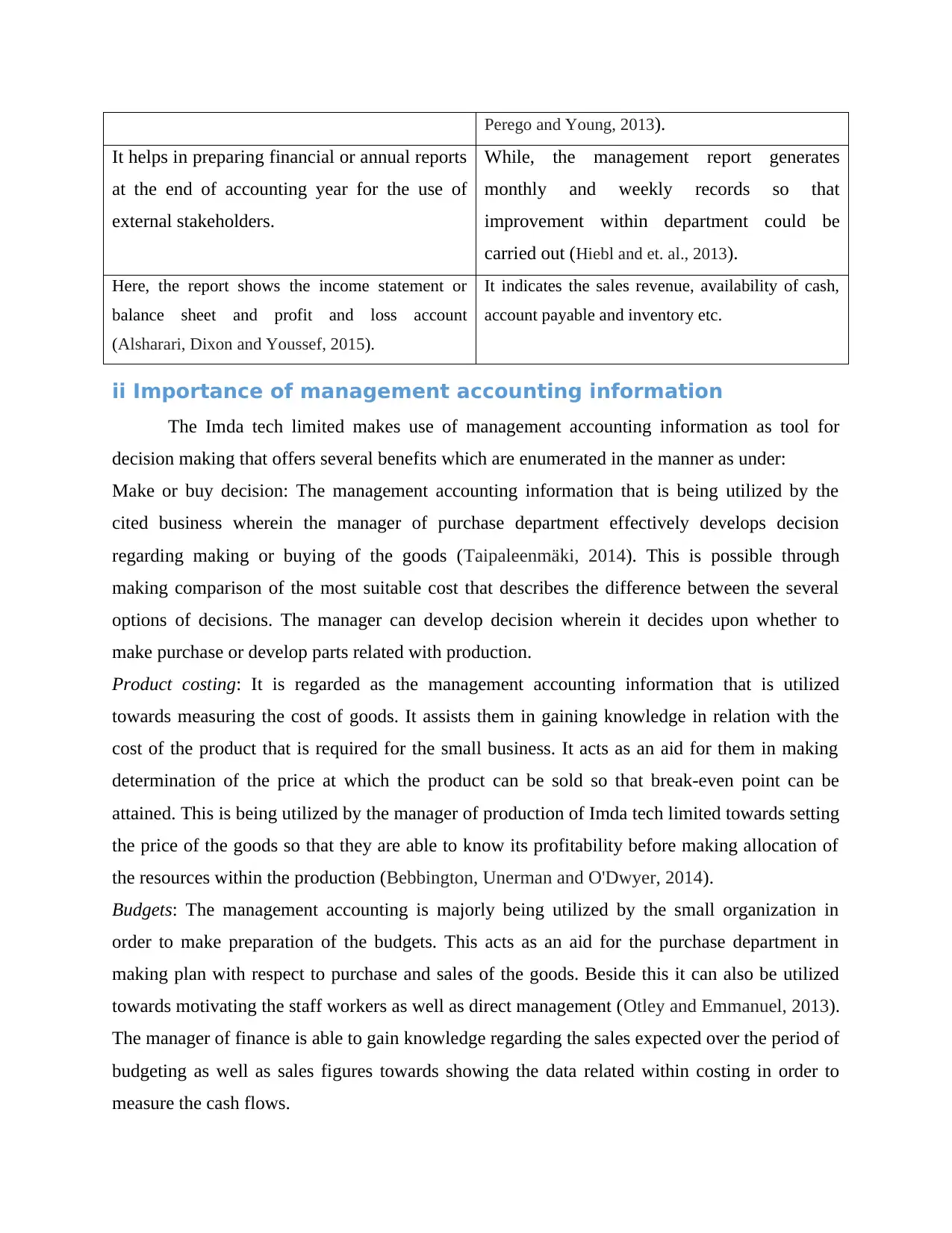
Perego and Young, 2013).
It helps in preparing financial or annual reports
at the end of accounting year for the use of
external stakeholders.
While, the management report generates
monthly and weekly records so that
improvement within department could be
carried out (Hiebl and et. al., 2013).
Here, the report shows the income statement or
balance sheet and profit and loss account
(Alsharari, Dixon and Youssef, 2015).
It indicates the sales revenue, availability of cash,
account payable and inventory etc.
ii Importance of management accounting information
The Imda tech limited makes use of management accounting information as tool for
decision making that offers several benefits which are enumerated in the manner as under:
Make or buy decision: The management accounting information that is being utilized by the
cited business wherein the manager of purchase department effectively develops decision
regarding making or buying of the goods (Taipaleenmäki, 2014). This is possible through
making comparison of the most suitable cost that describes the difference between the several
options of decisions. The manager can develop decision wherein it decides upon whether to
make purchase or develop parts related with production.
Product costing: It is regarded as the management accounting information that is utilized
towards measuring the cost of goods. It assists them in gaining knowledge in relation with the
cost of the product that is required for the small business. It acts as an aid for them in making
determination of the price at which the product can be sold so that break-even point can be
attained. This is being utilized by the manager of production of Imda tech limited towards setting
the price of the goods so that they are able to know its profitability before making allocation of
the resources within the production (Bebbington, Unerman and O'Dwyer, 2014).
Budgets: The management accounting is majorly being utilized by the small organization in
order to make preparation of the budgets. This acts as an aid for the purchase department in
making plan with respect to purchase and sales of the goods. Beside this it can also be utilized
towards motivating the staff workers as well as direct management (Otley and Emmanuel, 2013).
The manager of finance is able to gain knowledge regarding the sales expected over the period of
budgeting as well as sales figures towards showing the data related within costing in order to
measure the cash flows.
It helps in preparing financial or annual reports
at the end of accounting year for the use of
external stakeholders.
While, the management report generates
monthly and weekly records so that
improvement within department could be
carried out (Hiebl and et. al., 2013).
Here, the report shows the income statement or
balance sheet and profit and loss account
(Alsharari, Dixon and Youssef, 2015).
It indicates the sales revenue, availability of cash,
account payable and inventory etc.
ii Importance of management accounting information
The Imda tech limited makes use of management accounting information as tool for
decision making that offers several benefits which are enumerated in the manner as under:
Make or buy decision: The management accounting information that is being utilized by the
cited business wherein the manager of purchase department effectively develops decision
regarding making or buying of the goods (Taipaleenmäki, 2014). This is possible through
making comparison of the most suitable cost that describes the difference between the several
options of decisions. The manager can develop decision wherein it decides upon whether to
make purchase or develop parts related with production.
Product costing: It is regarded as the management accounting information that is utilized
towards measuring the cost of goods. It assists them in gaining knowledge in relation with the
cost of the product that is required for the small business. It acts as an aid for them in making
determination of the price at which the product can be sold so that break-even point can be
attained. This is being utilized by the manager of production of Imda tech limited towards setting
the price of the goods so that they are able to know its profitability before making allocation of
the resources within the production (Bebbington, Unerman and O'Dwyer, 2014).
Budgets: The management accounting is majorly being utilized by the small organization in
order to make preparation of the budgets. This acts as an aid for the purchase department in
making plan with respect to purchase and sales of the goods. Beside this it can also be utilized
towards motivating the staff workers as well as direct management (Otley and Emmanuel, 2013).
The manager of finance is able to gain knowledge regarding the sales expected over the period of
budgeting as well as sales figures towards showing the data related within costing in order to
measure the cash flows.
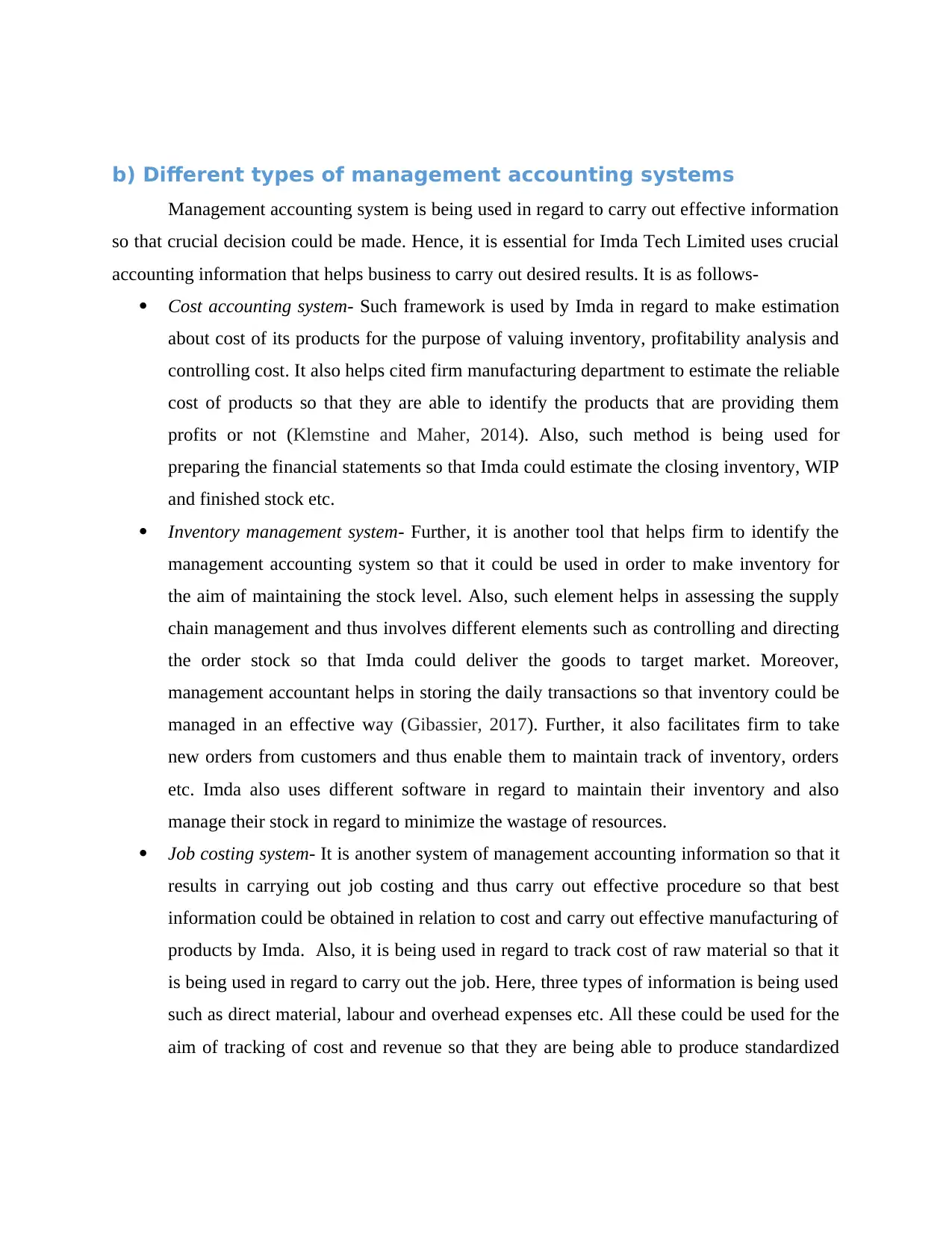
b) Different types of management accounting systems
Management accounting system is being used in regard to carry out effective information
so that crucial decision could be made. Hence, it is essential for Imda Tech Limited uses crucial
accounting information that helps business to carry out desired results. It is as follows-
Cost accounting system- Such framework is used by Imda in regard to make estimation
about cost of its products for the purpose of valuing inventory, profitability analysis and
controlling cost. It also helps cited firm manufacturing department to estimate the reliable
cost of products so that they are able to identify the products that are providing them
profits or not (Klemstine and Maher, 2014). Also, such method is being used for
preparing the financial statements so that Imda could estimate the closing inventory, WIP
and finished stock etc.
Inventory management system- Further, it is another tool that helps firm to identify the
management accounting system so that it could be used in order to make inventory for
the aim of maintaining the stock level. Also, such element helps in assessing the supply
chain management and thus involves different elements such as controlling and directing
the order stock so that Imda could deliver the goods to target market. Moreover,
management accountant helps in storing the daily transactions so that inventory could be
managed in an effective way (Gibassier, 2017). Further, it also facilitates firm to take
new orders from customers and thus enable them to maintain track of inventory, orders
etc. Imda also uses different software in regard to maintain their inventory and also
manage their stock in regard to minimize the wastage of resources.
Job costing system- It is another system of management accounting information so that it
results in carrying out job costing and thus carry out effective procedure so that best
information could be obtained in relation to cost and carry out effective manufacturing of
products by Imda. Also, it is being used in regard to track cost of raw material so that it
is being used in regard to carry out the job. Here, three types of information is being used
such as direct material, labour and overhead expenses etc. All these could be used for the
aim of tracking of cost and revenue so that they are being able to produce standardized
Management accounting system is being used in regard to carry out effective information
so that crucial decision could be made. Hence, it is essential for Imda Tech Limited uses crucial
accounting information that helps business to carry out desired results. It is as follows-
Cost accounting system- Such framework is used by Imda in regard to make estimation
about cost of its products for the purpose of valuing inventory, profitability analysis and
controlling cost. It also helps cited firm manufacturing department to estimate the reliable
cost of products so that they are able to identify the products that are providing them
profits or not (Klemstine and Maher, 2014). Also, such method is being used for
preparing the financial statements so that Imda could estimate the closing inventory, WIP
and finished stock etc.
Inventory management system- Further, it is another tool that helps firm to identify the
management accounting system so that it could be used in order to make inventory for
the aim of maintaining the stock level. Also, such element helps in assessing the supply
chain management and thus involves different elements such as controlling and directing
the order stock so that Imda could deliver the goods to target market. Moreover,
management accountant helps in storing the daily transactions so that inventory could be
managed in an effective way (Gibassier, 2017). Further, it also facilitates firm to take
new orders from customers and thus enable them to maintain track of inventory, orders
etc. Imda also uses different software in regard to maintain their inventory and also
manage their stock in regard to minimize the wastage of resources.
Job costing system- It is another system of management accounting information so that it
results in carrying out job costing and thus carry out effective procedure so that best
information could be obtained in relation to cost and carry out effective manufacturing of
products by Imda. Also, it is being used in regard to track cost of raw material so that it
is being used in regard to carry out the job. Here, three types of information is being used
such as direct material, labour and overhead expenses etc. All these could be used for the
aim of tracking of cost and revenue so that they are being able to produce standardized
⊘ This is a preview!⊘
Do you want full access?
Subscribe today to unlock all pages.

Trusted by 1+ million students worldwide
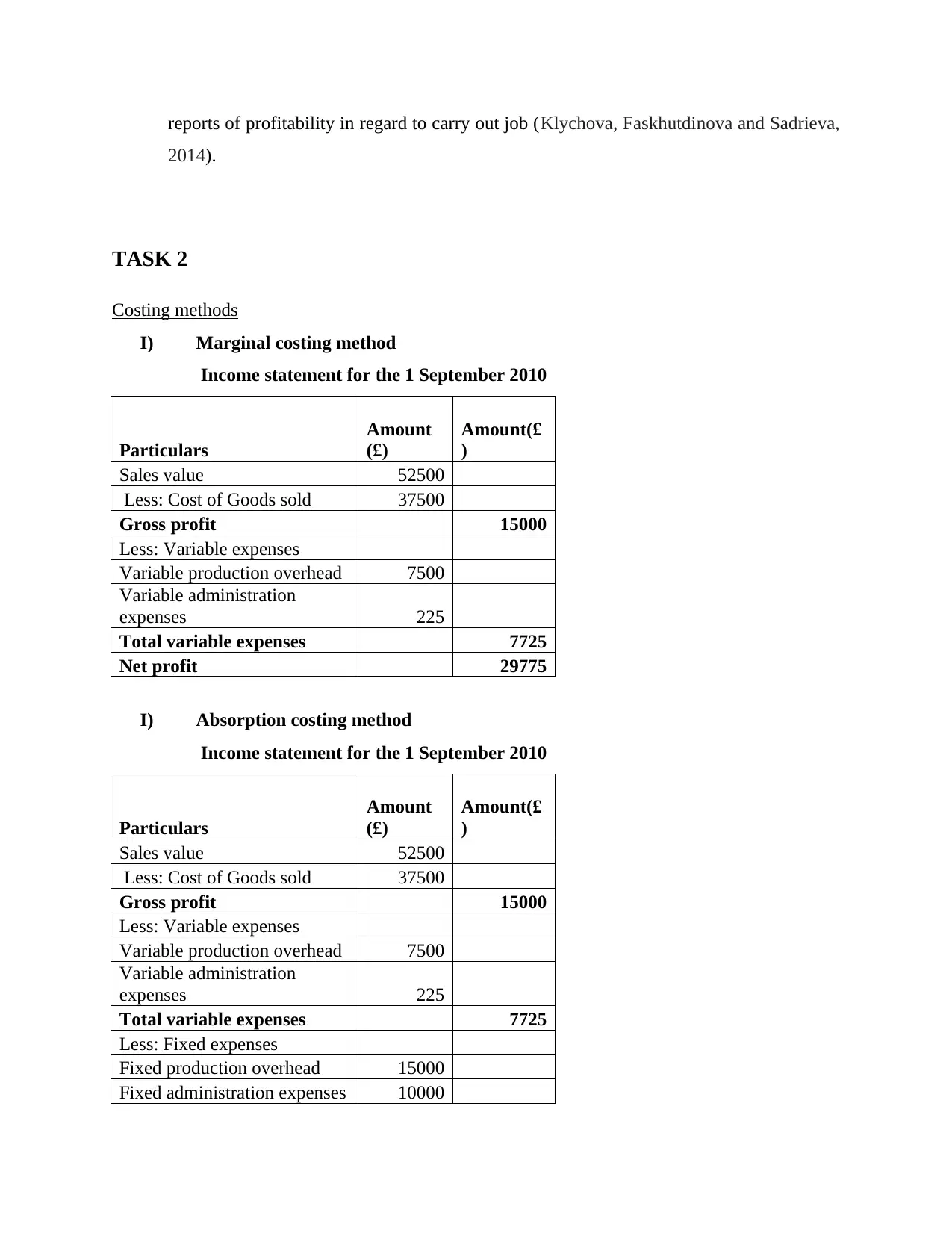
reports of profitability in regard to carry out job (Klychova, Faskhutdinova and Sadrieva,
2014).
TASK 2
Costing methods
I) Marginal costing method
Income statement for the 1 September 2010
Particulars
Amount
(£)
Amount(£
)
Sales value 52500
Less: Cost of Goods sold 37500
Gross profit 15000
Less: Variable expenses
Variable production overhead 7500
Variable administration
expenses 225
Total variable expenses 7725
Net profit 29775
I) Absorption costing method
Income statement for the 1 September 2010
Particulars
Amount
(£)
Amount(£
)
Sales value 52500
Less: Cost of Goods sold 37500
Gross profit 15000
Less: Variable expenses
Variable production overhead 7500
Variable administration
expenses 225
Total variable expenses 7725
Less: Fixed expenses
Fixed production overhead 15000
Fixed administration expenses 10000
2014).
TASK 2
Costing methods
I) Marginal costing method
Income statement for the 1 September 2010
Particulars
Amount
(£)
Amount(£
)
Sales value 52500
Less: Cost of Goods sold 37500
Gross profit 15000
Less: Variable expenses
Variable production overhead 7500
Variable administration
expenses 225
Total variable expenses 7725
Net profit 29775
I) Absorption costing method
Income statement for the 1 September 2010
Particulars
Amount
(£)
Amount(£
)
Sales value 52500
Less: Cost of Goods sold 37500
Gross profit 15000
Less: Variable expenses
Variable production overhead 7500
Variable administration
expenses 225
Total variable expenses 7725
Less: Fixed expenses
Fixed production overhead 15000
Fixed administration expenses 10000
Paraphrase This Document
Need a fresh take? Get an instant paraphrase of this document with our AI Paraphraser
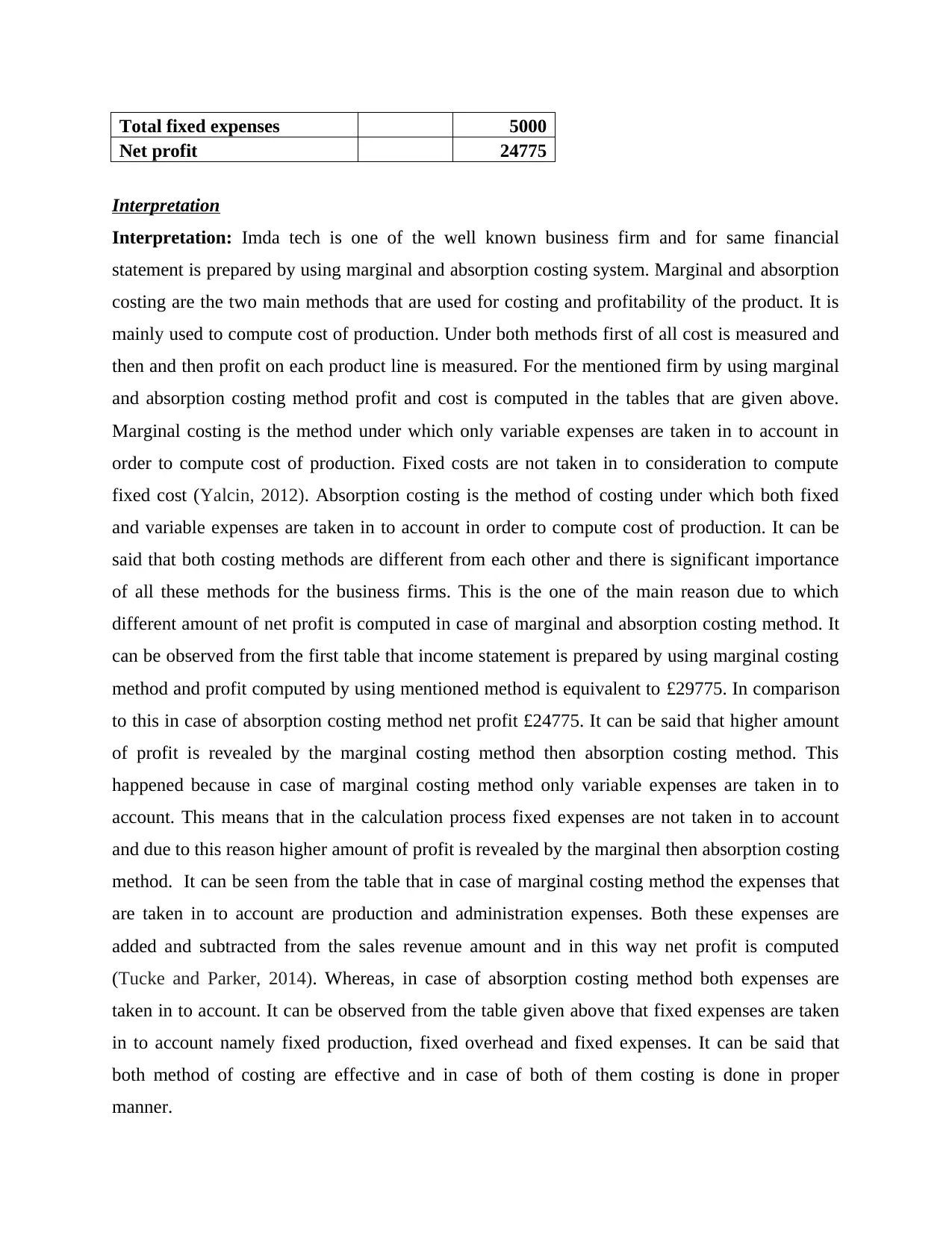
Total fixed expenses 5000
Net profit 24775
Interpretation
Interpretation: Imda tech is one of the well known business firm and for same financial
statement is prepared by using marginal and absorption costing system. Marginal and absorption
costing are the two main methods that are used for costing and profitability of the product. It is
mainly used to compute cost of production. Under both methods first of all cost is measured and
then and then profit on each product line is measured. For the mentioned firm by using marginal
and absorption costing method profit and cost is computed in the tables that are given above.
Marginal costing is the method under which only variable expenses are taken in to account in
order to compute cost of production. Fixed costs are not taken in to consideration to compute
fixed cost (Yalcin, 2012). Absorption costing is the method of costing under which both fixed
and variable expenses are taken in to account in order to compute cost of production. It can be
said that both costing methods are different from each other and there is significant importance
of all these methods for the business firms. This is the one of the main reason due to which
different amount of net profit is computed in case of marginal and absorption costing method. It
can be observed from the first table that income statement is prepared by using marginal costing
method and profit computed by using mentioned method is equivalent to £29775. In comparison
to this in case of absorption costing method net profit £24775. It can be said that higher amount
of profit is revealed by the marginal costing method then absorption costing method. This
happened because in case of marginal costing method only variable expenses are taken in to
account. This means that in the calculation process fixed expenses are not taken in to account
and due to this reason higher amount of profit is revealed by the marginal then absorption costing
method. It can be seen from the table that in case of marginal costing method the expenses that
are taken in to account are production and administration expenses. Both these expenses are
added and subtracted from the sales revenue amount and in this way net profit is computed
(Tucke and Parker, 2014). Whereas, in case of absorption costing method both expenses are
taken in to account. It can be observed from the table given above that fixed expenses are taken
in to account namely fixed production, fixed overhead and fixed expenses. It can be said that
both method of costing are effective and in case of both of them costing is done in proper
manner.
Net profit 24775
Interpretation
Interpretation: Imda tech is one of the well known business firm and for same financial
statement is prepared by using marginal and absorption costing system. Marginal and absorption
costing are the two main methods that are used for costing and profitability of the product. It is
mainly used to compute cost of production. Under both methods first of all cost is measured and
then and then profit on each product line is measured. For the mentioned firm by using marginal
and absorption costing method profit and cost is computed in the tables that are given above.
Marginal costing is the method under which only variable expenses are taken in to account in
order to compute cost of production. Fixed costs are not taken in to consideration to compute
fixed cost (Yalcin, 2012). Absorption costing is the method of costing under which both fixed
and variable expenses are taken in to account in order to compute cost of production. It can be
said that both costing methods are different from each other and there is significant importance
of all these methods for the business firms. This is the one of the main reason due to which
different amount of net profit is computed in case of marginal and absorption costing method. It
can be observed from the first table that income statement is prepared by using marginal costing
method and profit computed by using mentioned method is equivalent to £29775. In comparison
to this in case of absorption costing method net profit £24775. It can be said that higher amount
of profit is revealed by the marginal costing method then absorption costing method. This
happened because in case of marginal costing method only variable expenses are taken in to
account. This means that in the calculation process fixed expenses are not taken in to account
and due to this reason higher amount of profit is revealed by the marginal then absorption costing
method. It can be seen from the table that in case of marginal costing method the expenses that
are taken in to account are production and administration expenses. Both these expenses are
added and subtracted from the sales revenue amount and in this way net profit is computed
(Tucke and Parker, 2014). Whereas, in case of absorption costing method both expenses are
taken in to account. It can be observed from the table given above that fixed expenses are taken
in to account namely fixed production, fixed overhead and fixed expenses. It can be said that
both method of costing are effective and in case of both of them costing is done in proper
manner.
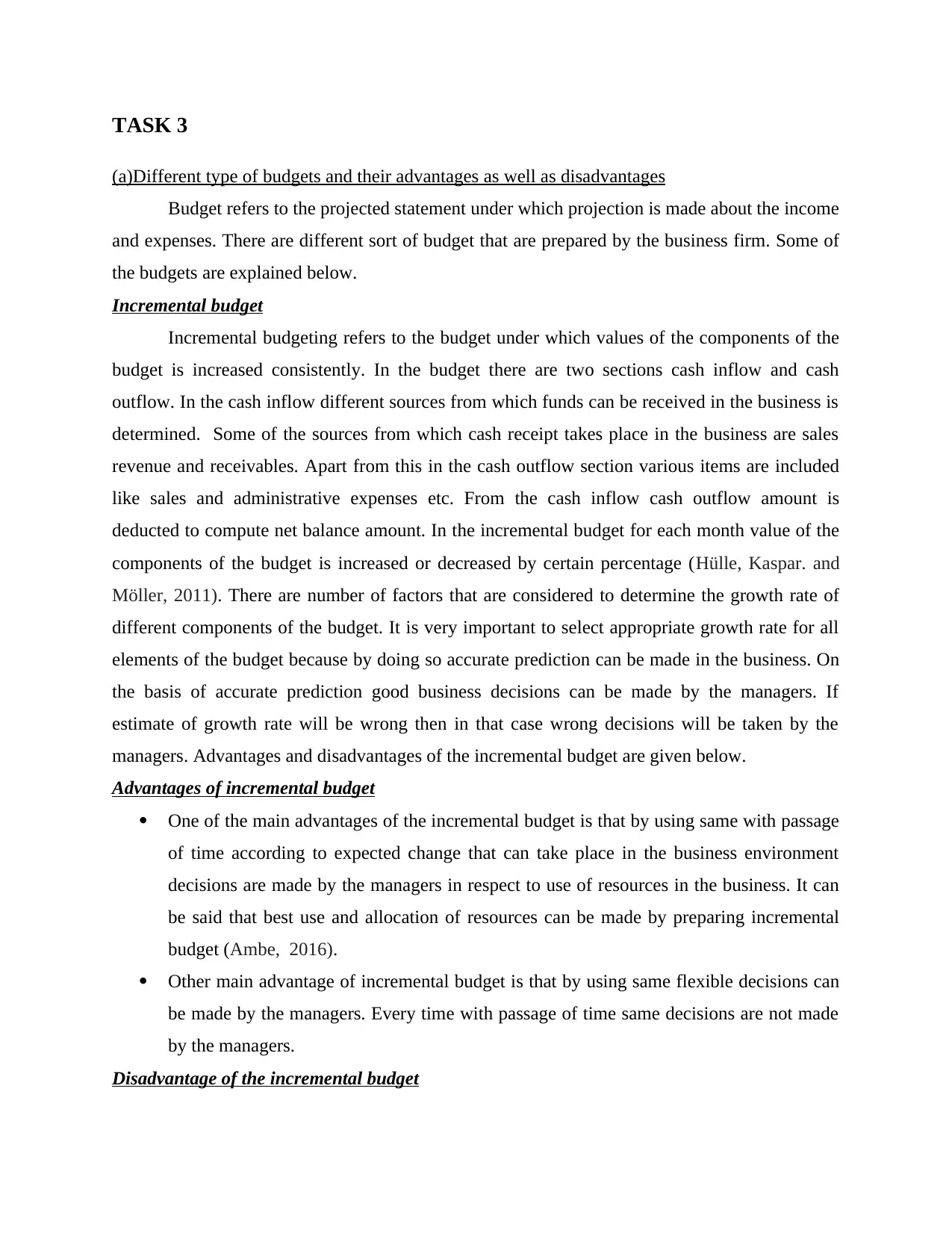
TASK 3
(a)Different type of budgets and their advantages as well as disadvantages
Budget refers to the projected statement under which projection is made about the income
and expenses. There are different sort of budget that are prepared by the business firm. Some of
the budgets are explained below.
Incremental budget
Incremental budgeting refers to the budget under which values of the components of the
budget is increased consistently. In the budget there are two sections cash inflow and cash
outflow. In the cash inflow different sources from which funds can be received in the business is
determined. Some of the sources from which cash receipt takes place in the business are sales
revenue and receivables. Apart from this in the cash outflow section various items are included
like sales and administrative expenses etc. From the cash inflow cash outflow amount is
deducted to compute net balance amount. In the incremental budget for each month value of the
components of the budget is increased or decreased by certain percentage (Hülle, Kaspar. and
Möller, 2011). There are number of factors that are considered to determine the growth rate of
different components of the budget. It is very important to select appropriate growth rate for all
elements of the budget because by doing so accurate prediction can be made in the business. On
the basis of accurate prediction good business decisions can be made by the managers. If
estimate of growth rate will be wrong then in that case wrong decisions will be taken by the
managers. Advantages and disadvantages of the incremental budget are given below.
Advantages of incremental budget
One of the main advantages of the incremental budget is that by using same with passage
of time according to expected change that can take place in the business environment
decisions are made by the managers in respect to use of resources in the business. It can
be said that best use and allocation of resources can be made by preparing incremental
budget (Ambe, 2016).
Other main advantage of incremental budget is that by using same flexible decisions can
be made by the managers. Every time with passage of time same decisions are not made
by the managers.
Disadvantage of the incremental budget
(a)Different type of budgets and their advantages as well as disadvantages
Budget refers to the projected statement under which projection is made about the income
and expenses. There are different sort of budget that are prepared by the business firm. Some of
the budgets are explained below.
Incremental budget
Incremental budgeting refers to the budget under which values of the components of the
budget is increased consistently. In the budget there are two sections cash inflow and cash
outflow. In the cash inflow different sources from which funds can be received in the business is
determined. Some of the sources from which cash receipt takes place in the business are sales
revenue and receivables. Apart from this in the cash outflow section various items are included
like sales and administrative expenses etc. From the cash inflow cash outflow amount is
deducted to compute net balance amount. In the incremental budget for each month value of the
components of the budget is increased or decreased by certain percentage (Hülle, Kaspar. and
Möller, 2011). There are number of factors that are considered to determine the growth rate of
different components of the budget. It is very important to select appropriate growth rate for all
elements of the budget because by doing so accurate prediction can be made in the business. On
the basis of accurate prediction good business decisions can be made by the managers. If
estimate of growth rate will be wrong then in that case wrong decisions will be taken by the
managers. Advantages and disadvantages of the incremental budget are given below.
Advantages of incremental budget
One of the main advantages of the incremental budget is that by using same with passage
of time according to expected change that can take place in the business environment
decisions are made by the managers in respect to use of resources in the business. It can
be said that best use and allocation of resources can be made by preparing incremental
budget (Ambe, 2016).
Other main advantage of incremental budget is that by using same flexible decisions can
be made by the managers. Every time with passage of time same decisions are not made
by the managers.
Disadvantage of the incremental budget
⊘ This is a preview!⊘
Do you want full access?
Subscribe today to unlock all pages.

Trusted by 1+ million students worldwide
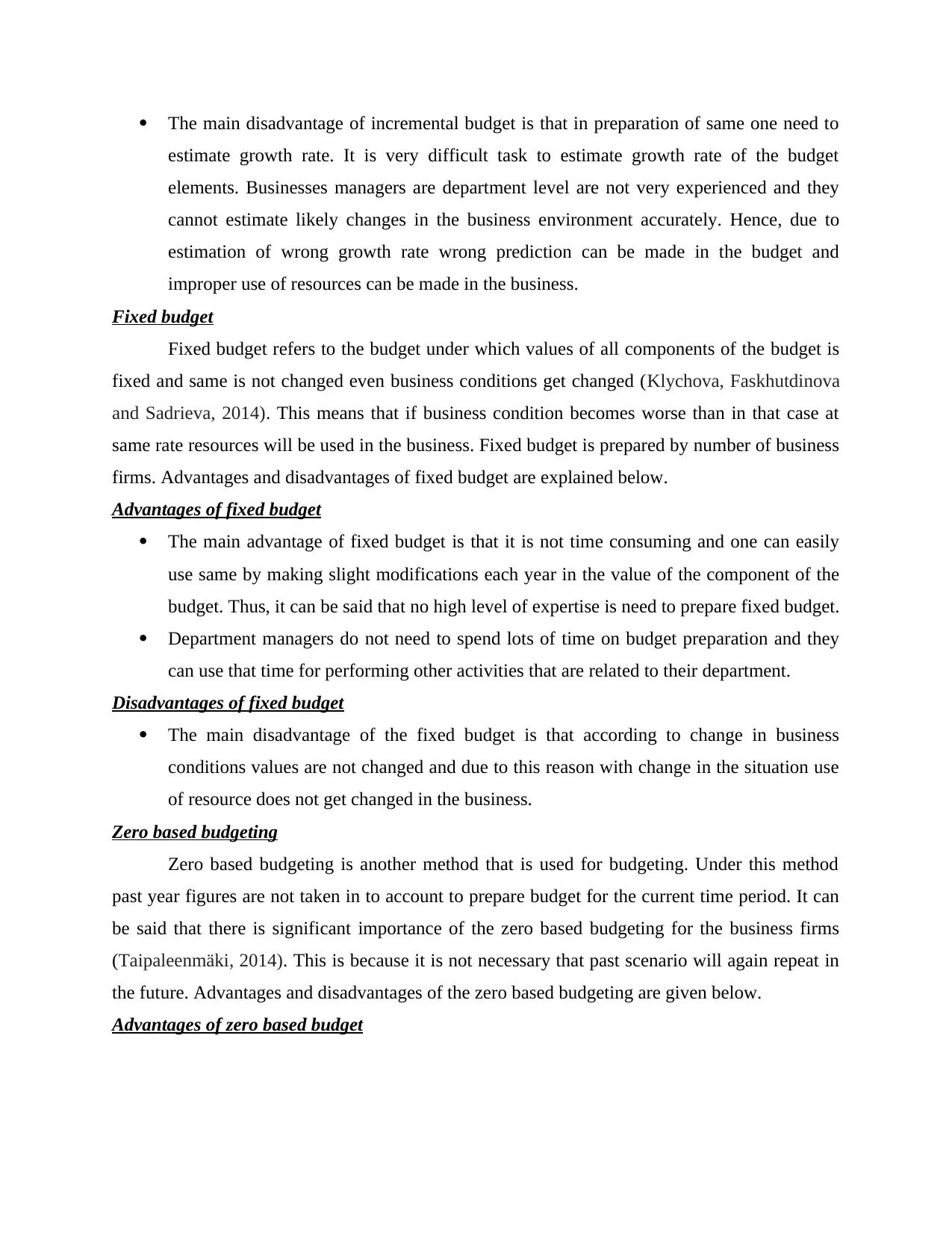
The main disadvantage of incremental budget is that in preparation of same one need to
estimate growth rate. It is very difficult task to estimate growth rate of the budget
elements. Businesses managers are department level are not very experienced and they
cannot estimate likely changes in the business environment accurately. Hence, due to
estimation of wrong growth rate wrong prediction can be made in the budget and
improper use of resources can be made in the business.
Fixed budget
Fixed budget refers to the budget under which values of all components of the budget is
fixed and same is not changed even business conditions get changed (Klychova, Faskhutdinova
and Sadrieva, 2014). This means that if business condition becomes worse than in that case at
same rate resources will be used in the business. Fixed budget is prepared by number of business
firms. Advantages and disadvantages of fixed budget are explained below.
Advantages of fixed budget
The main advantage of fixed budget is that it is not time consuming and one can easily
use same by making slight modifications each year in the value of the component of the
budget. Thus, it can be said that no high level of expertise is need to prepare fixed budget.
Department managers do not need to spend lots of time on budget preparation and they
can use that time for performing other activities that are related to their department.
Disadvantages of fixed budget
The main disadvantage of the fixed budget is that according to change in business
conditions values are not changed and due to this reason with change in the situation use
of resource does not get changed in the business.
Zero based budgeting
Zero based budgeting is another method that is used for budgeting. Under this method
past year figures are not taken in to account to prepare budget for the current time period. It can
be said that there is significant importance of the zero based budgeting for the business firms
(Taipaleenmäki, 2014). This is because it is not necessary that past scenario will again repeat in
the future. Advantages and disadvantages of the zero based budgeting are given below.
Advantages of zero based budget
estimate growth rate. It is very difficult task to estimate growth rate of the budget
elements. Businesses managers are department level are not very experienced and they
cannot estimate likely changes in the business environment accurately. Hence, due to
estimation of wrong growth rate wrong prediction can be made in the budget and
improper use of resources can be made in the business.
Fixed budget
Fixed budget refers to the budget under which values of all components of the budget is
fixed and same is not changed even business conditions get changed (Klychova, Faskhutdinova
and Sadrieva, 2014). This means that if business condition becomes worse than in that case at
same rate resources will be used in the business. Fixed budget is prepared by number of business
firms. Advantages and disadvantages of fixed budget are explained below.
Advantages of fixed budget
The main advantage of fixed budget is that it is not time consuming and one can easily
use same by making slight modifications each year in the value of the component of the
budget. Thus, it can be said that no high level of expertise is need to prepare fixed budget.
Department managers do not need to spend lots of time on budget preparation and they
can use that time for performing other activities that are related to their department.
Disadvantages of fixed budget
The main disadvantage of the fixed budget is that according to change in business
conditions values are not changed and due to this reason with change in the situation use
of resource does not get changed in the business.
Zero based budgeting
Zero based budgeting is another method that is used for budgeting. Under this method
past year figures are not taken in to account to prepare budget for the current time period. It can
be said that there is significant importance of the zero based budgeting for the business firms
(Taipaleenmäki, 2014). This is because it is not necessary that past scenario will again repeat in
the future. Advantages and disadvantages of the zero based budgeting are given below.
Advantages of zero based budget
Paraphrase This Document
Need a fresh take? Get an instant paraphrase of this document with our AI Paraphraser
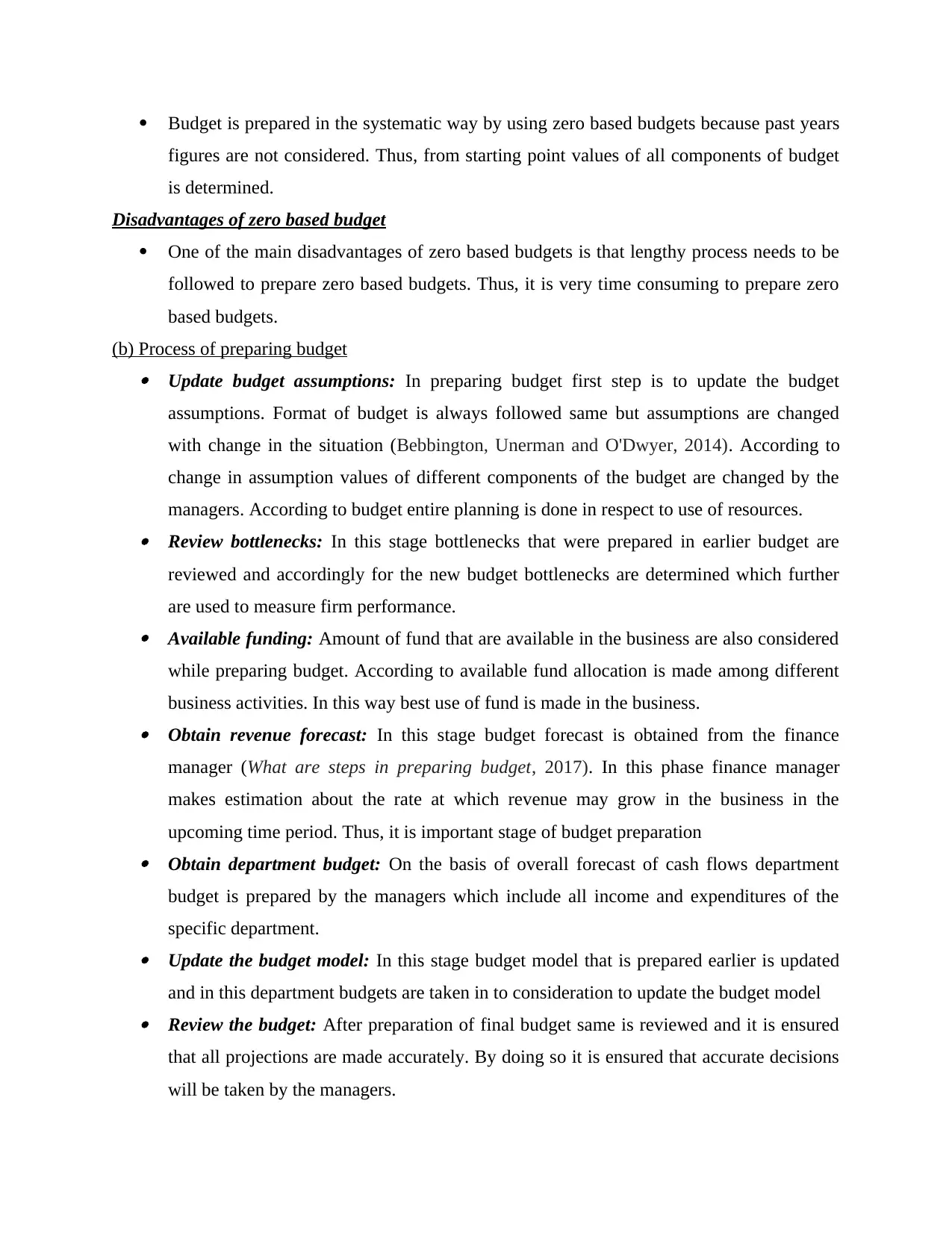
Budget is prepared in the systematic way by using zero based budgets because past years
figures are not considered. Thus, from starting point values of all components of budget
is determined.
Disadvantages of zero based budget
One of the main disadvantages of zero based budgets is that lengthy process needs to be
followed to prepare zero based budgets. Thus, it is very time consuming to prepare zero
based budgets.
(b) Process of preparing budget Update budget assumptions: In preparing budget first step is to update the budget
assumptions. Format of budget is always followed same but assumptions are changed
with change in the situation (Bebbington, Unerman and O'Dwyer, 2014). According to
change in assumption values of different components of the budget are changed by the
managers. According to budget entire planning is done in respect to use of resources. Review bottlenecks: In this stage bottlenecks that were prepared in earlier budget are
reviewed and accordingly for the new budget bottlenecks are determined which further
are used to measure firm performance. Available funding: Amount of fund that are available in the business are also considered
while preparing budget. According to available fund allocation is made among different
business activities. In this way best use of fund is made in the business. Obtain revenue forecast: In this stage budget forecast is obtained from the finance
manager (What are steps in preparing budget, 2017). In this phase finance manager
makes estimation about the rate at which revenue may grow in the business in the
upcoming time period. Thus, it is important stage of budget preparation Obtain department budget: On the basis of overall forecast of cash flows department
budget is prepared by the managers which include all income and expenditures of the
specific department. Update the budget model: In this stage budget model that is prepared earlier is updated
and in this department budgets are taken in to consideration to update the budget model Review the budget: After preparation of final budget same is reviewed and it is ensured
that all projections are made accurately. By doing so it is ensured that accurate decisions
will be taken by the managers.
figures are not considered. Thus, from starting point values of all components of budget
is determined.
Disadvantages of zero based budget
One of the main disadvantages of zero based budgets is that lengthy process needs to be
followed to prepare zero based budgets. Thus, it is very time consuming to prepare zero
based budgets.
(b) Process of preparing budget Update budget assumptions: In preparing budget first step is to update the budget
assumptions. Format of budget is always followed same but assumptions are changed
with change in the situation (Bebbington, Unerman and O'Dwyer, 2014). According to
change in assumption values of different components of the budget are changed by the
managers. According to budget entire planning is done in respect to use of resources. Review bottlenecks: In this stage bottlenecks that were prepared in earlier budget are
reviewed and accordingly for the new budget bottlenecks are determined which further
are used to measure firm performance. Available funding: Amount of fund that are available in the business are also considered
while preparing budget. According to available fund allocation is made among different
business activities. In this way best use of fund is made in the business. Obtain revenue forecast: In this stage budget forecast is obtained from the finance
manager (What are steps in preparing budget, 2017). In this phase finance manager
makes estimation about the rate at which revenue may grow in the business in the
upcoming time period. Thus, it is important stage of budget preparation Obtain department budget: On the basis of overall forecast of cash flows department
budget is prepared by the managers which include all income and expenditures of the
specific department. Update the budget model: In this stage budget model that is prepared earlier is updated
and in this department budgets are taken in to consideration to update the budget model Review the budget: After preparation of final budget same is reviewed and it is ensured
that all projections are made accurately. By doing so it is ensured that accurate decisions
will be taken by the managers.

© Pricing strategies
There are different sort of pricing strategies that are prepared by the business firms. Some
of these pricing strategies are explained below. Market skimming strategy: Market skimming strategy is one under which at high price
product is sold in the market. It must be noted that this pricing strategy is followed in the
monopoly market. Due to less competitors firm easily sale product at high price and earn
high profit in business. Price penetration strategy: Price penetration strategy is one under which at low price
product is sold in the market. It is the one of the most important strategy because under
same in order to survive in the market firm sold its product at low price in the market. Competition based pricing: Competition based pricing is one under which by
considering price that is charged by the competitor’s price of the product is determined
and at that price product is sold in the market.
TASK 4
a) Balance score card approach
Earlier the business make use of traditional methods in order to make evaluation of the past
years performance but today there is presence of several tools that assist in measuring
performance of the firm. Balance scorecard approach is considered as approach that is being
utilized by the firm for measurement of the whole performance. It makes evaluation of working
based upon the four criteria that includes financial, internal process, customers as well as
learning or growth. It makes evaluation of the business efforts for making future enhancement in
the firm (Fullerton, Kennedy and Widener, 2013). This not only lays emphasis over the financial
performance of Balance scorecard approach but also takes into account non financial perspective
as well.
Financial perspective: Balance score card approach pays greater attention over the cash
flow, sales, growth, income as well as equity. In case cash flow increases then such
implies that business has attained the profitability and has made sound performance
within the financial year (Bhimani and et. al., 2013).
There are different sort of pricing strategies that are prepared by the business firms. Some
of these pricing strategies are explained below. Market skimming strategy: Market skimming strategy is one under which at high price
product is sold in the market. It must be noted that this pricing strategy is followed in the
monopoly market. Due to less competitors firm easily sale product at high price and earn
high profit in business. Price penetration strategy: Price penetration strategy is one under which at low price
product is sold in the market. It is the one of the most important strategy because under
same in order to survive in the market firm sold its product at low price in the market. Competition based pricing: Competition based pricing is one under which by
considering price that is charged by the competitor’s price of the product is determined
and at that price product is sold in the market.
TASK 4
a) Balance score card approach
Earlier the business make use of traditional methods in order to make evaluation of the past
years performance but today there is presence of several tools that assist in measuring
performance of the firm. Balance scorecard approach is considered as approach that is being
utilized by the firm for measurement of the whole performance. It makes evaluation of working
based upon the four criteria that includes financial, internal process, customers as well as
learning or growth. It makes evaluation of the business efforts for making future enhancement in
the firm (Fullerton, Kennedy and Widener, 2013). This not only lays emphasis over the financial
performance of Balance scorecard approach but also takes into account non financial perspective
as well.
Financial perspective: Balance score card approach pays greater attention over the cash
flow, sales, growth, income as well as equity. In case cash flow increases then such
implies that business has attained the profitability and has made sound performance
within the financial year (Bhimani and et. al., 2013).
⊘ This is a preview!⊘
Do you want full access?
Subscribe today to unlock all pages.

Trusted by 1+ million students worldwide
1 out of 17
Related Documents
Your All-in-One AI-Powered Toolkit for Academic Success.
+13062052269
info@desklib.com
Available 24*7 on WhatsApp / Email
![[object Object]](/_next/static/media/star-bottom.7253800d.svg)
Unlock your academic potential
Copyright © 2020–2025 A2Z Services. All Rights Reserved. Developed and managed by ZUCOL.





